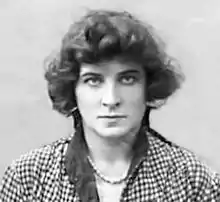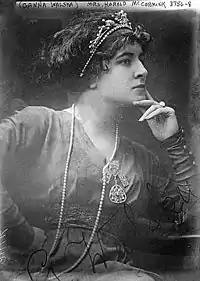Ganna Walska
Ganna Walska (born Hanna Puacz on June 26, 1887 – March 2, 1984) was a Polish opera singer and garden enthusiast who created the Lotusland botanical gardens at her mansion in Montecito, California. She was married six times, four times to wealthy husbands. The lavish promotion of her lackluster opera career by her fourth husband, Harold Fowler McCormick, inspired aspects of the screenplay for Citizen Kane.
Ganna Walska | |
|---|---|
 Passport photo of Ganna Walska (1920) | |
| Born | Hanna Puacz June 26, 1887 |
| Died | March 2, 1984 (aged 96) |
| Nationality | Polish |
| Known for | Opera Garden design |
| Spouse(s) |
|
Biography
Ganna Walska was born Hanna Puacz on 26 June 1887 in Brest, Russian Empire, to Polish parents Napoleon Puacz and Karolina Massalska.[1] Ganna is a Russian form of Hannah, and Walska "reminiscent of her favorite music, the waltz".[2]

In 1922, after her marriage to Harold F. McCormick, Ganna Walska purchased the Théâtre des Champs-Élysées in Paris. She told the Chicago Tribune that she had invested her own funds, not those of her wealthy husband, and said, "I will never appear in my own theatre until I have gained recognition based solely on my merits as an artist."[3]
Walska became a student of vocal teacher Cécile Gilly. Marjorie Lawrence, another student of Gilly's, stated that it was clear that Walska had little aptitude for music, but that Gilly took her on for the money.[4]
Walska pursued a career as an opera singer. The lavish promotion of her opera career by McCormick—despite her apparent reputation as a mediocre singer—inspired aspects of the screenplay for Orson Welles's Citizen Kane.[5] Roger Ebert, in his DVD commentary on Citizen Kane, suggests that the character of Susan Alexander was based on Walska. McCormick spent thousands of dollars on voice lessons for her and even arranged for Walska to take the lead in a production of Zazà by Ruggero Leoncavallo at the Chicago Opera in 1920. Reportedly, Walska got into an argument with director Pietro Cimini during dress rehearsal and stormed out of the production before she appeared. Contemporaries said Walska had a terrible voice, pleasing only to McCormick.
New York Times headlines of the day read, "Ganna Walska Fails as Butterfly: Voice Deserts Her Again When She Essays Role of Puccini's Heroine" (January 29, 1925), and "Mme. Walska Clings to Ambition to Sing" (July 14, 1927).
"According to her 1943 memoirs, Always Room at the Top, Walska had tried every sort of fashionable mumbo jumbo to conquer her nerves and salvage her voice," reported The New York Times in 1996. "Nothing worked. During a performance of Giordano's Fedora in Havana she veered so persistently off key that the audience pelted her with rotten vegetables. It was an event that Orson Welles remembered when he began concocting the character of the newspaper publisher's second wife for Citizen Kane."[6]
In 1926 Walska purchased the Duchess of Marlborough Fabergé egg that had been offered by Consuelo Vanderbilt at a charity auction. It was later acquired by Malcolm Forbes as the first Easter egg in his Fabergé egg collection.[7]
Ganna Walska died on March 2, 1984, at Lotusland, leaving her garden and her fortune to the Ganna Walska Lotusland Foundation.[8]
Marriages
Ganna Walska was married six times:
- Russian baron, Arcadie d'Eingorn, a Russian officer. They married in 1904 but the marriage was dissolved two years later. The baron died of tuberculosis in 1915.[9][10]
- Dr. Joseph Fraenkel, a New York endocrinologist. They were married in 1916, and he died in April 1920.[9][10]
- Multimillionaire sportsman and carpet tycoon Alexander Smith Cochran. They married in September 1920, and divorced in 1922.[9][10] He died in 1929.[11]
- Industrialist Harold Fowler McCormick. They married August 11, 1922 at the City Hall in Passy in Paris.[9] They divorced in 1931. He died in 1941.[12]
- English inventor of a death ray, Harry Grindell Matthews.[13] They married in 1938 and he died in 1941.[14][15]
- Theos Bernard, her sixth and last husband. He was a scholar of hatha yoga and Tibetan Buddhism and the author of books on the philosophy of India and Tibet. They married in 1942 and divorced in 1946. He died in 1947.[16]
Lotusland
.jpg.webp)
In 1941, with the encouragement of her sixth husband Theos Bernard, she purchased the historic 37-acre (15 ha) "Cuesta Linda" estate in Montecito near Santa Barbara, California, intending to use it as a retreat for Tibetan monks. Due to restrictions on wartime visas, the monks were unable to come to the United States. After her divorce from Bernard in 1946, Walska changed the name of her estate to Lotusland (after a famous flower held sacred in Indian and Tibetan religions, the lotus, Nelumbo nucifera) and the lotus growing in several of her garden's ponds.[17] She devoted the rest of her life to designing, redesigning, expanding, and maintaining the estate's renowned innovative and extensive gardens. Her landscape design talent is well regarded for distinctive gardens of exceptional creativity.
Honors
- Gold Cross of Merit from the Polish government in 1931
- Légion d'honneur order from the French government in 1934
- L'Ordre National des Arts et des Letters from the French government in 1972
References
- Pinkowski Files – a database of American Polonia http://www.poles.org/db/w_names/Walska_G.html
- About Madame Walska http://www.lotusland.org/about-us/about-madame-walska
- "Walska Buys Theatre." The New York Times, December 15, 1922
- Marjorie Lawrence, Interrupted Melody (Sydney: Invincible Press, 1949), p. 64.
- Welles, Orson, and Peter Bogdanovich, This is Orson Welles. New York: HarperCollins Publishers 1992 ISBN 0-06-016616-9 page 49
- Mitchell Owens (August 22, 1996). "Garden of the Slightly Macabre". New York Times. Retrieved 2012-09-04.
- Faberge – Treasures of Imperial Russia Archived August 23, 2007, at the Wayback Machine (retrieved January 16, 2012)
- Ganna Walska Lotusland Foundation
- "Walska the Bride of H. F. McCormick. Wedded in Quiet Paris Ceremony, With Mr. and Mrs. Malone the Only Witnesses. Posting Of Banns Waived. Official Says Couple Gave an 'Immense Amount' to Poor. Union Illegal in Illinois". New York Times. Associated Press. August 12, 1922. Retrieved 2012-09-04.
Harold F. McCormick of Chicago, Chairman of the Executive Committee of the International Harvester Company, and Mrs. Alexander Smith Cochran, known to the music world as Mme. Ganna Walska, were married quietly today in the City Hall of the select Passy district of Paris.
- "Walska Makes Counter Charge Against Cochran". Chicago Tribune. March 31, 1922. Retrieved 2012-09-04.
...her first husband Arcadie d Eighnhorn [sic], a Russian, who is said to have died in Russia in 1920. Her second husband Dr. Joseph Fraenkel ...
- "A. S. Cochran Dies At Saranac Lake. Wealthy Carpet Manufacturer, Philanthropist and Yachtsman. Inherited Vast Fortunes. Democratic Ways and Generosity Made Him Greatly Admired In Native Yonkers. Chief Owner of Vast Carpet Works. Built Yacht to Defend Cup. Joined British Navy in War". New York Times. June 21, 1929. Retrieved 2012-09-04.
Alexander Smith Cochran, carpet manufacturer, philanthropist and yachtsman of New York and Yonkers, died here last night of pulmonary tuberculosis, from which he had been suffering for fifteen years. He was in his fifty-sixth year.
- "Harold Fowler McCormick, Industrialist. Dies. Chairman of the International Harvester Co., Which His Father, Cyrus, Founded. Noted As Philanthropist. Sponsored Successful Search for Scarlet Fever Antitoxin. A Supporter of Opera". New York Times. October 17, 1941. Retrieved 2012-09-04.
Mrs. McCormick died in 1935. Mr. McCormick's second wife was Mme. Ganna Walska. Their union was solemnized in 1922. Mme. Walska's ambition to sing in grand ...
- "Married". Time. February 7, 1938. Retrieved 2007-07-21.
Ganna Walska d'Eighnhorn Fraenkel Cochran McCormick, 45, Polish-American opera singer, perfumer, feminist, whose four previous husbands had owned fortunes totaling $125,000,000, to Harry Grindell-Matthews, 57, inventor of the 'death ray,' which knocked out a cow 200 yards distant at its first British War Office tests; in London. The bride went on her honeymoon alone, while the investor rushed to his Clydach, Wales laboratory (fenced with electrified wire) to perfect an aerial torpedo.
- "Scientist Asserts He'll Wed Walska. Grindell-Matthews,'Death Ray' Inventor, Says He Will Marry Polish Opera Singer Soon. They Met 3 Months Ago. Marriage Would Be the Fifth for Mme. Walska, Once Wife of Harold Fowler McCormick". New York Times. August 20, 1937. Retrieved 2012-09-04.
Harry Grindell-Matthews, genial 57-year old 'death ray' inventor, said today that he would marry Ganna Walska, Polish opera singer whose fourth husband was Harold Fowler McCormick, Chicago harvester magnate.
- "Died". Time. September 22, 1941. Retrieved 2007-07-21.
Harry Grindell-Matthews, 61, inventor of a highly publicized 'death ray,' fifth husband of Singer Ganna Walska; in his lonely, electrically guarded bungalow laboratory near Swansea, Wales. An electrical researcher, he developed submarine detectors, 'aerial mines,' remote-control devices, sound-film synchronization, in 1911 established wireless communication with a plane in flight.
- Kunimoto, Namiko (2011). "Traveler-as-Lama Photography and the Fantasy of Transformation in Tibet". Trans Asia Photography Review. 2 (1: The Elu[va]sive Portrait: In Pursuit of Photographic Portraiture in East Asia and Beyond, Guest edited by Ayelet Zohar, Fall 2011).
- "The Life and Works of Theos Bernard". Columbia University. Retrieved 11 August 2016.
Further reading
- Adams, Brian (2015) [2014]. Ganna: Diva of Lotusland. CreateSpace. ISBN 978-1-5141-6957-5.
External links
| Wikimedia Commons has media related to Ganna Walska. |
- Ganna Walska at IMDb
- Ganna Walska Lotusland, Frommer's Review
- Lotusland history
- "Chicago's Citizen Kane" (About.com) at the Wayback Machine (archived October 11, 2006)
- About Citizen Kane (Humanities 140, "Approaches to Film," Winona State University) — Archived October 22, 2007, at the Wayback Machine
- Kiester, Edwin Jr., "Not your average backyard gardener" (abstract). Smithsonian Magazine, March 1997
- McPherson, Sean K., "Enemy of the Average." The New York Times, April 14, 2002
- Swartley, Ariel, "A diva who loved high drama." Los Angeles Times, March 10, 2005